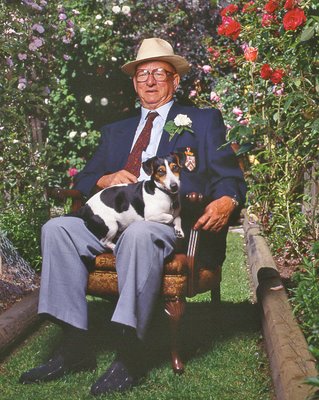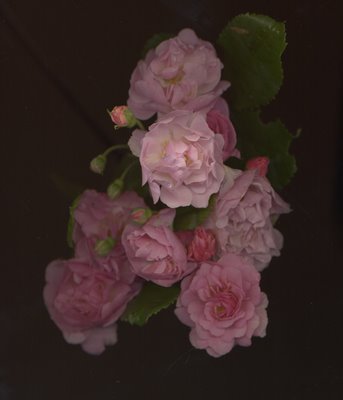The Reverend J.H. Pemberton and Erskine McPherson's Buttonhole
Monday, June 25, 2007

A couple of years ago I walked into McLeod's Books on West Pender and spotted Reverend Joseph H. Pemberton's Roses - Their History, Development And Cultivation. It was a 1908 first edition. Many of the pages had not been cut. This meant that the book had probably never been read. Trying to give my friend and owner of the used book store, Don Stewart my best poker face I asked him for the price. He said, "$50.00 but for you it will be $40.00." I could have sold the book to a collector for $200 that same day but I would never sell this treasure. In the early 20s Pemberton introduced a new class of roses (the first of the modern rose shrubs) that featured smallish flowers but that compensated by being extremely fragrant and which grew in large clusters. Pemberton called them Hybrid Musks.
Pemberton's (1852-1926) account on how he first became interested in roses is enough reason to want to keep it. Here it is:
My early recollections of church-going are associated with roses. We went every Sunday morning to an old Queen Anne church: ours was a square pew; the pew opener, a woman, walked before us, opened the pew door and shut us in. We sat round facing one another, but could not see anything except the gallery having the royal arms in the centre, the children who sat there with the village schoolmaster, who was also parish clerk and gave out the hymns. When standing-up time came I had to stand on the seat to see over the top of the pew. In a neighbouring pew there was a gentleman who appeared every Sunday with a rose in his buttonhole; I admired that rose and resolved to wear as good if not a better one the next Sunday. During the week I was on the look-out for a suitable one, and when Sunday came again it was gathered – Moss, White-crested Moss, Red Provence at first and then Baron de Maynard or Boule de Neige were favourites. I appeared with my bloom, and when the time came to mount the seat compared it with the rose in the buttonhole of the rival. The result of the judging was usually adverse to me, but I always went home hoping for better luck next time. My flowers were handicapped by the staging; you see I was in petticoats at first and wore a light-coloured Norfolk jacket, large mother-of-pearl buttons down the front and a belt. My rival had a black coat, and the rose had a buttonhole all to itself; there is nothing like black to set off a rose, specially when added to this the flower did not have to share the buttonhole with a large button. I was quite aware of the drawback, and longed for the time when I might have a cloth jacket with a buttonhole on the side.
---------------------------------------------------------------------------------------------------------------------------------
Apart from the autobiographical gem from his book, I have been unable to find much information on the Reverend Pemberton, who was born in Essex and lived there most of his life. He died in 1926, one year after he hybridized one of his most popular roses, Rosa 'Cornelia'. Here you see a scan of my specimen. Cornelia's blooms are smallish but they come in giant clusters. Best of all, besides having that odd but attractive moschata (musk) fragrance, she is extremely shade tolerant and disease resistant. I have also been unable to find any image of Pemberton.

When Rosemary first took me to a Vancouver Rose Society meeting some 15 years ago I suffered on the hard chairs and the interminable projection of bad rose slides. The only light moments of those evenings were provided by a giant and bald old man with a booming voice. Erskine McPherson had the driest and most wonderful humour and could really grow roses. In the picture above, which I took a few years before his recent death you can spot the rose in his lapel and his beloved Jack Terrier, whose name was Jack. With no existing image of the Reverend Joseph Pemberton it is not too hard for me to imagine that the Reverend Pemberton and Erskine McPherson perhaps looked the same.
Another of my Pemberton favourites is Rosa 'Penelope' and Rosa 'Bishop of Darlington'. Of the latter I wish I could find out who the man was and why Pemberton would dedicate and name a rose after him.






